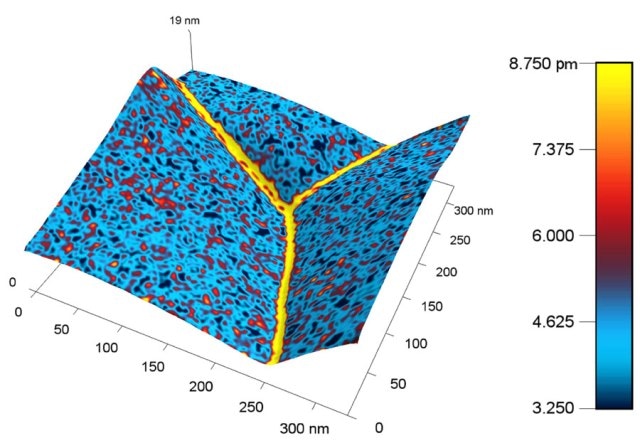Jun 2 2016
A novel tool that can help improve batteries and fuel cells was developed by a group of American and Chinese scientists.
 A nanoscale map of the metal ceria produced with the new probe shows a higher response, represented by a yellow color, near the boundary between grains of metal. The higher response corresponds to a higher concentration of charged species. (Credit- Ehsan Nasr Esfahani/University of Washington)
A nanoscale map of the metal ceria produced with the new probe shows a higher response, represented by a yellow color, near the boundary between grains of metal. The higher response corresponds to a higher concentration of charged species. (Credit- Ehsan Nasr Esfahani/University of Washington)
Battery technology has traversed milestones after Alessandro Volta had first arranged metal discs in a “voltaic pile” to produce electricity. However, significant advancements are still required to meet the future energy challenges, like storing renewable energy in an efficient and cost effective way and powering electric cars.
According to Jiangyu Li, Professor of Mechanical Engineering, University of Washington in Seattle, the solution to the required enhancement most probably lies within the nanoscale. The nanoscale is so small that the landscape can be altered by the movement of a several atoms or molecules. Li and his co-workers have probed into the nano world to assist researchers in understanding how batteries actually work. They published their findings in the Journal of Applied Physics, from AIP Publishing.
Through chemical reactions, batteries and fuel cells generate electricity. The speed of the reactions decides the speed at which the battery charges, the amount of power it can supply, and its rate of degradation.
Even though the battery electrode material may seem to be uniform to the human eye, the environment is extremely different at the atomic level.
Large variations in properties can occur at the interface between materials and near the surface. These changes could influence the rates of the reaction in complex ways.
Studies performed in the last decade or so have shown the extent to which local variations in material properties can influence the performance of electrochemical systems, including batteries, Li stated.
It is difficult to comprehend the exact processes of chemical reactions due to the intricate nanoscale landscape, but “it may also create new opportunities to engineer materials properties so as to achieve quantum leaps in performance,” Li said.
Li and his team created a nanoscale probe to better understand the progress of chemical reactions at the atomic and molecular level. This technique is similar to atomic force microscopies where a small cantilever “feels” the material and constructs a map of its properties having a resolution of nm or lesser.
The cantilever gets heated by an electrical current in the new electrochemical probe, thereby leading to variations in localized stress and temperature of the material under the probe. Consecutively, ions and atoms within the material move about leading to expansion and contraction, which in turn vibrates the cantilever. This vibration can be precisely measured by shining a laser beam on top of the cantilever.
If a large concentration of charged particles like ions is present near the tip of the probe, variations in their concentration would deform the material further, just like how wood swells as soon as it gets wet. This deformation is referred to as Vegard strain.
Standard thermal expansion and Vegard strain influence the material’s vibration in different ways. The thermally-induced Vegard strain was more like a harmonic overtone, playing one octave higher than the notes, if the vibrations were like the musical notes, explained Li.
This instrument could detect the Vegard strain-induced vibrations and could extrapolate the electronic flaws and ion concentration surrounding the probe tip. This method provides many benefits over different kinds of atomic microscopy that utilize voltage perturbations to produce a response. This is because voltage can generate various types of responses and it is not easy to separate the response part related to shifts in electronic defect and ionic concentration. It is easier to detect thermal responses. The drawback of this system is that it can probe only at rates lesser than the heat transfer processes surrounding the tip.
According to the researchers, this method may act as a useful tool for analyzing the electrochemical material properties at the nanoscale. They analyzed it by determining the concentration of charged species in LiFePO4 and Sm-doped ceria, which are vital materials in lithium batteries and solid oxide fuel cells, respectively.
The concentration of ionic and electronic species are often tied to important rate properties of electrochemical materials -- such as surface reactions, interfacial charge transfer, and bulk and surface diffusion -- that govern the device performance. By measuring these properties locally on the nanoscale, we can build a much better understanding of how electrochemical systems really work, and thus how to develop new materials with much higher performance.
Jiangyu Li, Professor of Mechanical Engineering, University of Washington in Seattle